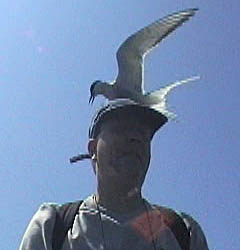I know they are in the small copse 100yds up the road, because I've heard them, but I've never heard one from the garden, let alone seen one. And why would a hole nesting bird get it so wrong? The sparrowhawk was around today so maybe it was being chased, but Emma didn't mention a sprawk. Odd. Maybe it was the light. Talking of nuthatches and light ........
Last weekend I finally had a chance to go back to the Forest of Dean, to try out my new makeshift hide and more specifically to try it on the hawfinches, assuming they were still there. Sitting in the car park waiting for Chris Grady a nuthatch caught my eye. Perched at a hole it didn't take much to work out that it was nesting there. The light was poor (after all those gorgeous days - life isn't fair sometimes), but I got a few snaps. They do show how the birds had filled in the hole with mud to take it down to the right size for them. As the books say the way the mud blended with the bark was quite impressive.
Nearby a long tailed tit was collecting feathers for a nest that Chris pointed out in the hedge. In fact at one point it had so many it looked more like the feathers were collecting the tit. Focusing aganst the hedge was a bit tricky for my Panasonic, but at this resolution the snap almost looks acceptable. This was the first LTT nest I had seen, but it was as neat as I had expected. Good site to revsist when they're feeding the young.
So it was off to the hawfinch site. The hide went up easily enough and it wasn't long before a female great spotted woodpecker dropped in nearby. So at least it wasn't completely scary.
Next up were three grey squirrels, and again the hide seemed to work. This wasn't a tourist spot where they are particularly tame, so something was right.And then finally came the metallic 'tic' call of the the stars of the show, although the light only held for the first visit. They were a bit shy, staying to one end of the clearing - not because of my hide, though. Chris had already explained that they had been doing that for a little while - possibly the result of the ringers using this as a netting spot. Still an improvement on my past views, even if not the best pics. The sheer size of the bill is quite remarkable, but the other thing I had never noticed before this year was the pattern of the blue feathers over the males rump. If you click on the last picture you might see this on the bigger version that appears. Better still click on my link to Chris' website and see some fabulous close ups which show this beautifully.


























No comments:
Post a Comment